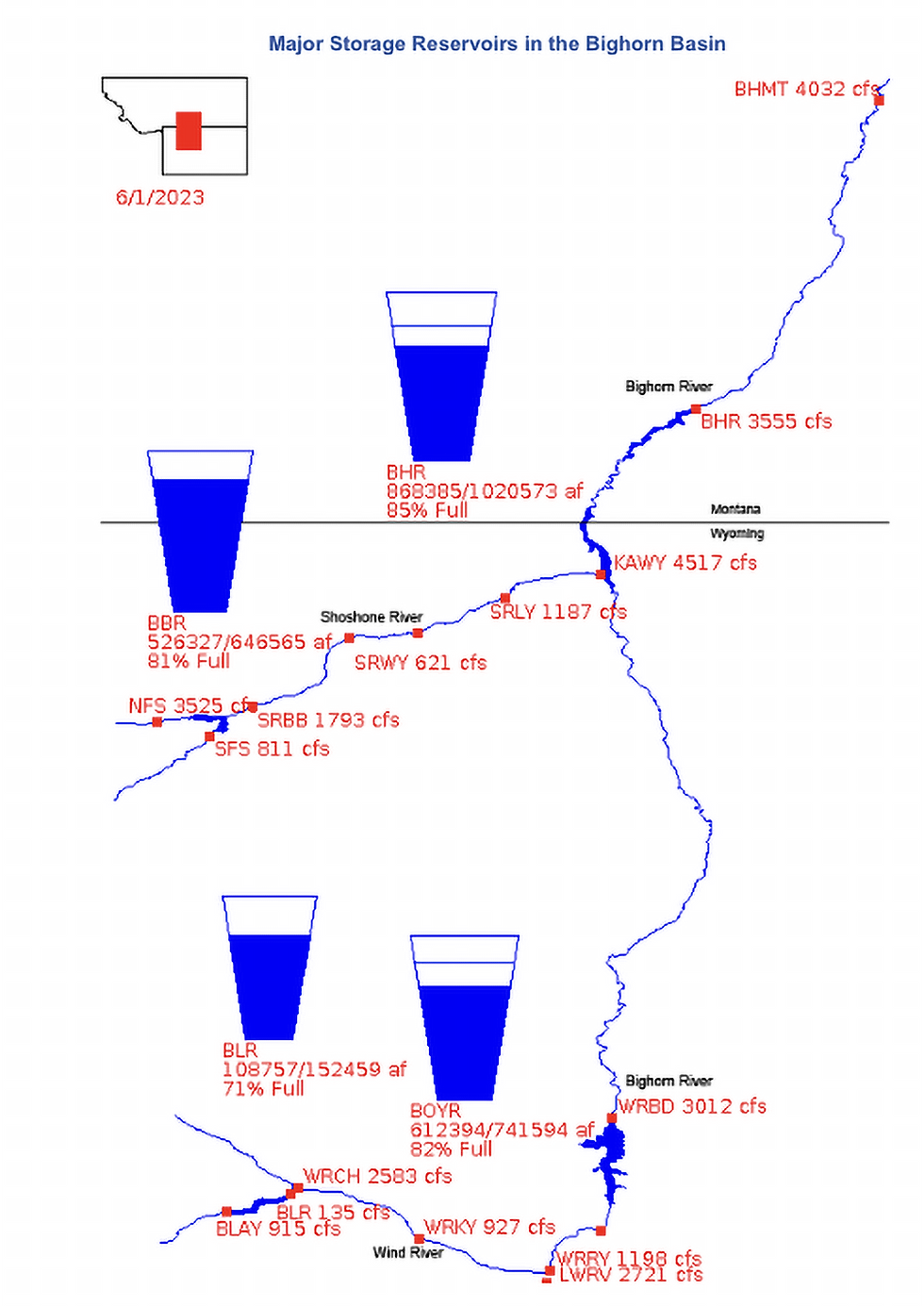June River Outlook
- emery582
- Jun 2, 2023
- 4 min read
Author: Anne Marie Emery
June has arrived bringing heavy rain on the Bighorn River, and some anglers can't help but feel a bit of concern over if recent wet conditions will result in a substantial increase in river flow. This is a valid concern shared by many who remember the high, sustained flow events that impacted the wild trout fishery between 2011-2018. While we do not have a crystal ball when it comes to spring precipitation, we do have some perspective on snowpack and storage that we hope will ease those feeling a little unsure of where we stand for June. *For Bottom Line, go to last paragraph.
In June, or during run-off, Bighorn River flows are determined by (but not limited to) three primary variables: the timing and magnitude of snowmelt and inflows, storage availability of upstream reservoirs and spring precipitation. Water managers update current conditions and forecasts on these variables daily throughout the runoff period to balance the needs of both the reservoir and the river. However, while variables such as snowpack and reservoir levels are physically measurable and observable, there is always forecasting uncertainty when it comes to late season precipitation. Below we provide a quick overview of the variables being considered at this time of year.
SNOWMELT TIMING AND MAGNITUDE
Snowpack is rapidly depleting in the Bighorn basin, with mountain ranges surrounding the basin dropping below average for this time of year (see Figure 1). The earlier-than-average depletion of high elevation snowpack, and the effort to sustain flows above 2,500cfs throughout the summer, is the primary reason BOR reduced flows to 3,000cfs in May. The good news is that with reduced snowpack, we do not have to worry about sudden “rain on snow” events that, in the past, have caused more water to enter the system than managers could keep up with. Snowmelt occurred earlier than average in 2023 and at a more gradual equating to a manageable snowmelt runoff.

Figure 1: SWE values for the Bighorn Basin have depleted below average for this time of year.
UPSTREAM STORAGE CAPACITY
Upstream reservoirs play an important role in capturing water that can be used throughout the summer season for multiple purposes. Dam managers operate spring reservoir levels in consideration of current snowpack conditions, inflows passed from upstream dams, and spring forecasts and in consideration to the river downstream. Each month, the BOR releases a monthly operating plan that project upcoming reservoir and river releases based on minimum, median and maximum inflow conditions. While we have yet to receive the operating plan for the month of June, the May Operations plan showed May-July inflows to be 79% of average. Considering the low snowpack levels, below average inflow and the current storage capacity of Bighorn Lake (85% full) we anticipate flows remaining at or below 3,500cfs in June, with the exception of unforeseen precipitation events that are impossible to cast long-term projections. Currently the reservoir is filling and is expected to fill to full capacity which is a good sign for 2024 winter flow release rates.
Figure 2: Current (6/1/2023) teacup diagram of reservoir storage availability within the Bighorn Basin.
PRECIPITATION
Yesterday, anglers in Fort Smith were alarmed to receive 1.14 inches of rain throughout the evening hours. However, in Big Horn County, Wyoming only 0.14 inches was received during the same period. Understanding the variability in precipitation between the two states, and within the basin, is important as it is primarily Wyoming rainfall and inflows that affect the fill rate of the Bighorn reservoir and Yellowtail dam river releases. On average, the Montana side of the basin receives more precipitation in June than the Wyoming side, so anglers should feel somewhat at ease knowing that what they are experiencing on the river may not be indicative of what is occurring upstream. However, precipitation is highly variable and unpredictable in both Montana and Wyoming in June, and managing these events are only as accurate as the current weather forecasts.

Figure 3: June precipitation averages for the Bighorn Basin in Wyoming (blue line) vs. Montana (orange line) from 1966-2022. The 30-year average for June for the Montana portion of the basin is 2.45 inches and the Wyoming June average is 1.68 inches.
BOTTOM LINE
We are not concerned but are keeping a watchful eye on things. Reservoir storage is available for the little snowpack we have left and the only factor that could affect river flows are substantial Wyoming rainfall events- events that (based on 30 years of data) are of less magnitude than what typically occurs on the Montana side of the basin. However, let’s remember that a short peak of high flows in June (although not expected this year) is not detrimental to the trout fishery. Spring freshets, although depressed by presence of the Yellowtail dam, are a natural part of the runoff cycle and can be beneficial to the river and its wild trout and can even help the macroinvertebrate community. We are not (at this time) anticipating conditions that would result in high river flows. The river has currently been increased to a perfect flow of 3500cfs in response to the 14-day precipitation forecast and BWO's are hatching, trout are rising, spawning grounds are being monitored by the BHRA drone and all things are looking wonderful on the Bighorn River.
Note: Spring conditions can change rapidly based on weather and forecasts. BHRA posts all flow changes on its Facebook page, and monthy operating plans on its website. To view current, real-time conditions, including river temperatures, river flows and reservoir levels visit the BHRA website homepage and click on River Conditions at top of page.











Comments